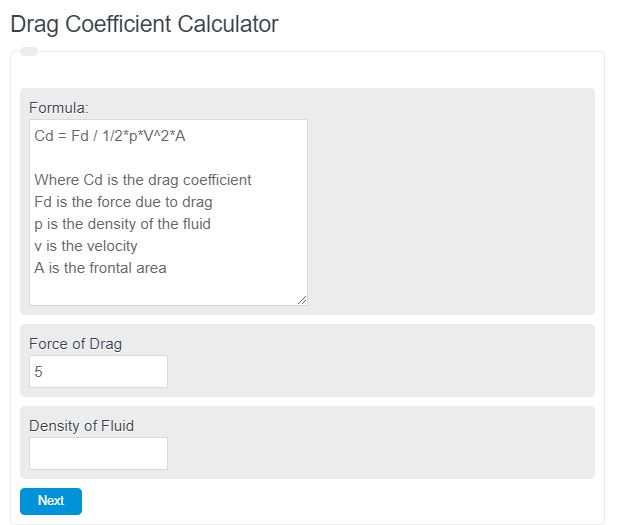Enter the force of drag, the density of the fluid, velocity, and frontal area of the body. The calculator will display the drag coefficient of this object.
- Bernoulli Equation Calculator
- Drag Equation Calculator
- Pipe Flow Calculator
- Lift Force Calculator
- Takeoff Velocity Calculator
- Drag Per Unit Span Calculator
Drag Coefficient Formula
The following formula is used to calculate the drag coefficient of an object.
Cd = Fd / 1/2*p*V^2*A
- Where Cd is the drag coefficient
- Fd is the force due to drag
- p is the density of the fluid
- v is the velocity
- A is the frontal area
Drag Coefficient Definition
A drag coefficient is a unitless measure of the resistance to movement through a fluid an object has due to its shape.
How to calculate a drag coefficient?
How to calculate a drag coefficient?
- First, determine the drag force acting on the object
Something that’s fairly unique about the coefficient of drag, is that it needs to be calculated using experimental data. To date, there is no accurate way to calculate it with data. So, in order to calculate the coefficient, a test needs to be set up that allows one to measure the force acting on the object.
- Next, measure the velocity and density of the fluid
Using your test setup information, or device, determine the velocity of the fluid moving around the object. (This could also be the velocity of the object itself.)
- Next, measure the frontal area
Calculate or measure the frontal area of the object. This is the area exposed to the force of drag.
- Calculate
Calculate the drag coefficient using the information from the steps above.
FAQ
A drag coefficient is a coefficient used to describe how aerodynamic a certain object is. That is, how much force acts on an object moving through a fluid relative to its size and the flow speed.
This is done by reducing the drag coefficient. Decrease the frontal area and change the shape to change the coefficient.

